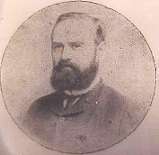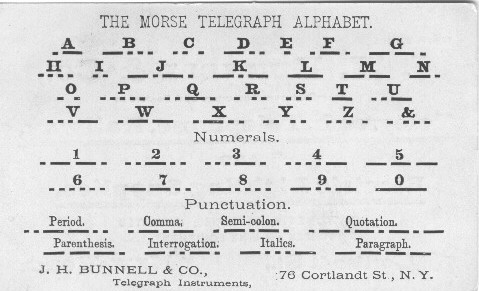

|
|
|
|
Samuel Morse's original code was designed for the landline telegraph service. It
worked well with the mechanical sounders heard in the telegraph stations.
However, with use, some characters we changed by
various users in various countries. In
1912 at the Radiotelegraphic Convention meeting in London, it was decided that
all radio signals would be sent using International Morse. Thus the confusion of
various operators inter-mixing the two code was eliminated. American Morse remained the standard
for U.S. landline telegraph companies, as it could be sent about 5% faster than International
Morse. American Morse was also commonly used for domestic radio
traffic on the Great Lakes and along the coasts. International Morse
was used on
ocean-going vessels. Many shipboard operators were skilled at
using both versions of the Morse code. Today, American Morse is nearly extinct. It was last used by the railroads.
Some Civil War re-enactments use American Morse for historical accuracy.
A . _
O . .
The difference between the Morse and
the
Continental (International)
codes The Continental Morse Code was accepted as the International Morse
Code and was used worldwide. The original Morse Code became the
American Morse Code and was used for railroad telegraphy in the United
States through the 1960's.
American Morse
History of J.H. Bunnell & Company
A Telegraph Office
Other Telegraph Instruments J. H. Bunnell Co., 80 Locust Drive, Kings Park,
NY 11754
In 1848 Germany created a standard which eliminated the long spaces and long dashes.
The new standard also changed the code for the numerical characters. This
modified version of the Morse code was accepted in 1865 throughout Europe and
became known as Continental Morse. Later, as Continental Morse was accepted for
use around the world, it became known as International Morse. The original
version of Morse code became known as American Morse.
B _ . . .
P . . . . .
C . . .
Q . . _ .
D _ . .
R . . .
E .
S . . .
F . - .
T _
G _ _ .
U . . _
H . . . .
V . . . _
I . .
W . _ _
J _ . _ .
X . _ . .
K _ . _
Y . . . .
L ____
(long
dash) Z . . . .
M _ _
N _ .
1 . _ _ .
6 . . . . . .
2 . . _ . .
7 - - . .
3 . . . _ .
8 _ . . . .
4 . . . . _
9 _ . . _
5 _ _ _
0 _______
(very long dash)
Samuel Morse
C . . . C _ . _ .
F
. _ . F . . _ .
J
_ . _ . J . _ _ _
L
___[long dash] L . _ . .
O
. . O _ _ _
P
. . . . . P . _ _ .
Q
. . _ . Q _ _ . _
R
. . . R . _ .
X
. _ . . X _ . . _
Y
. . . . Y _ . _ _
Z
. . . . Z _ _ . .
1 . _ _ .
1 . _ _ _ _
2 . . _ . .
2 . . _ _ _
3 . . . _ .
3 . . . _ _
5 _ _ _
5 . . . . .
6 . . . . . .
6 _ . . . .
7 _ _ . .
7 _ _ . . .
8 _ . . . .
8 _ _ _ . .
9 _ . . _
9 _ _ _ _ .
0 _______
0 _ _ _ _ _

Learning to be a Telegrapher
The Morse and Continental Codes
The Lineman's Job and Equipment
Telegraphy Publications
Telegraphy Links
Purchase a Mini-Key
Purchase a Navy Flame Proof key
Home
631-360-1967 - FAX 631-361-2173 - jhbunnell@optonline.net